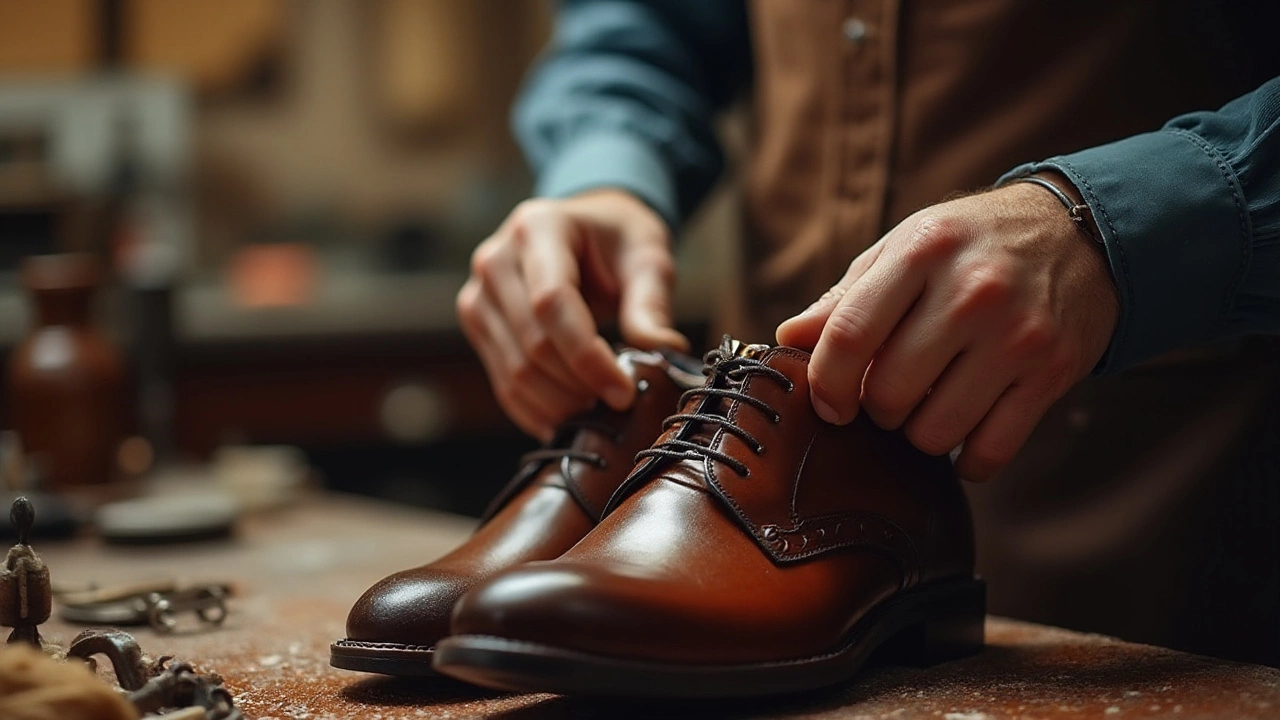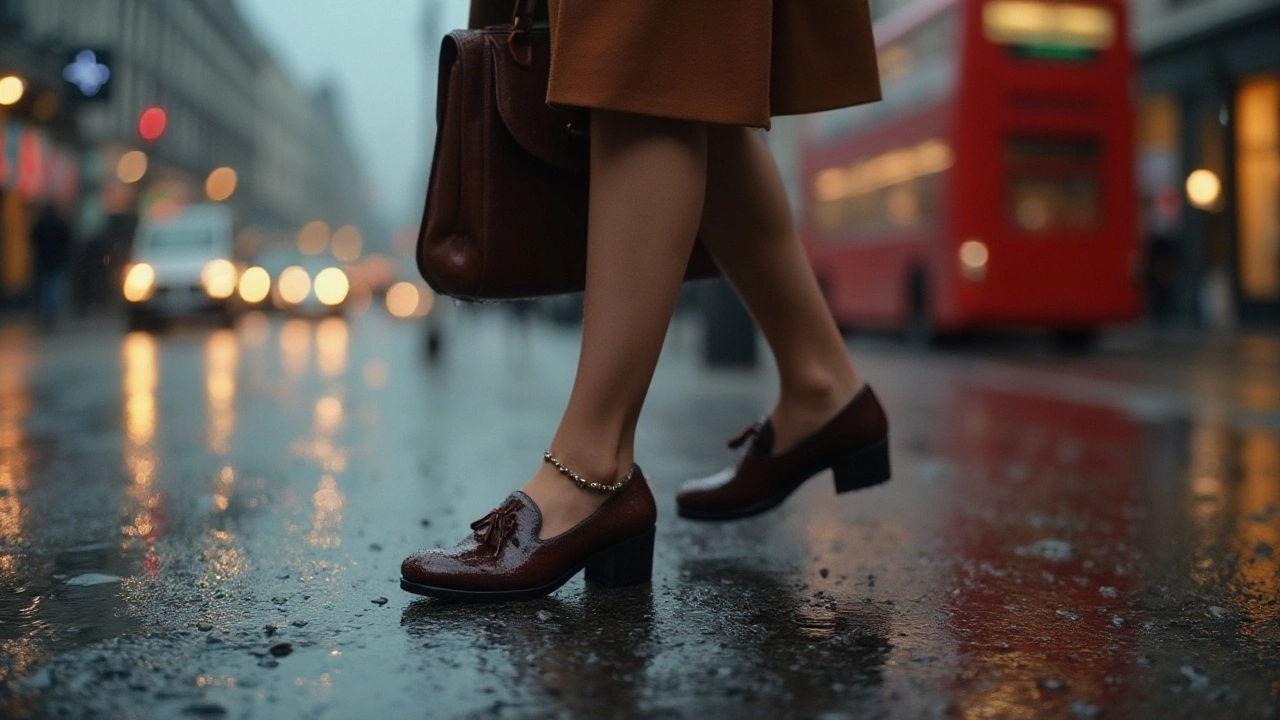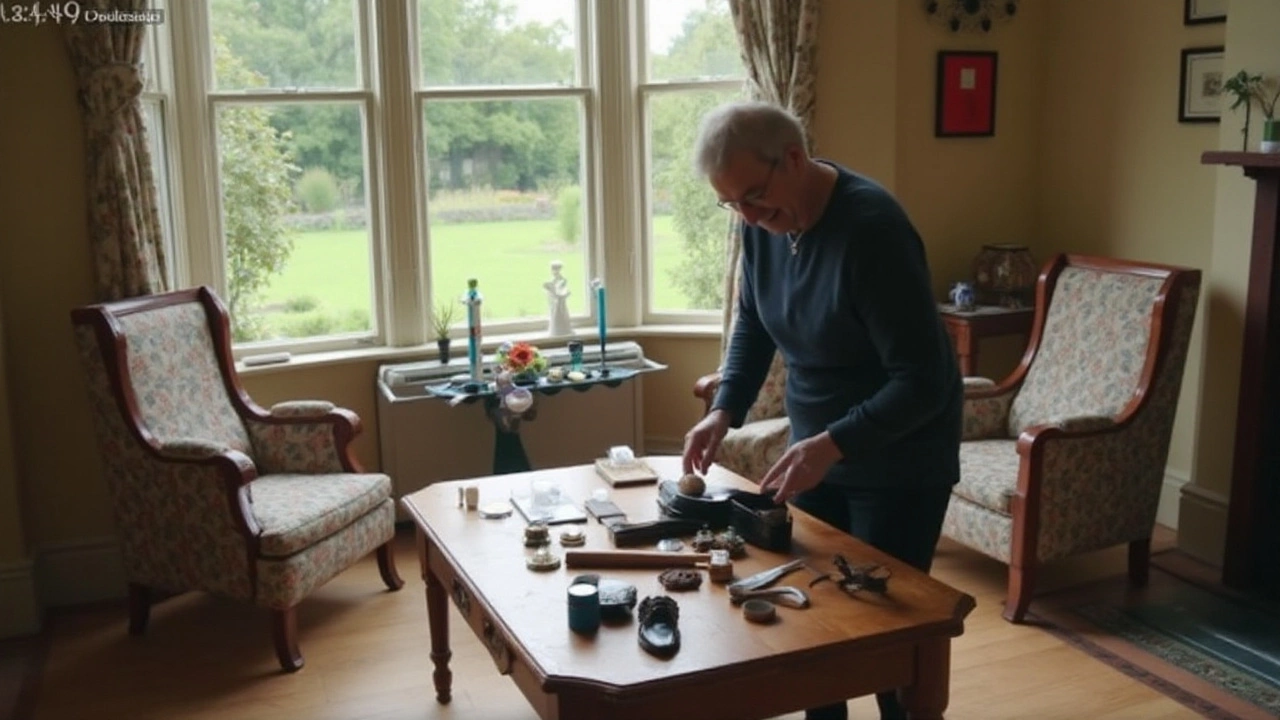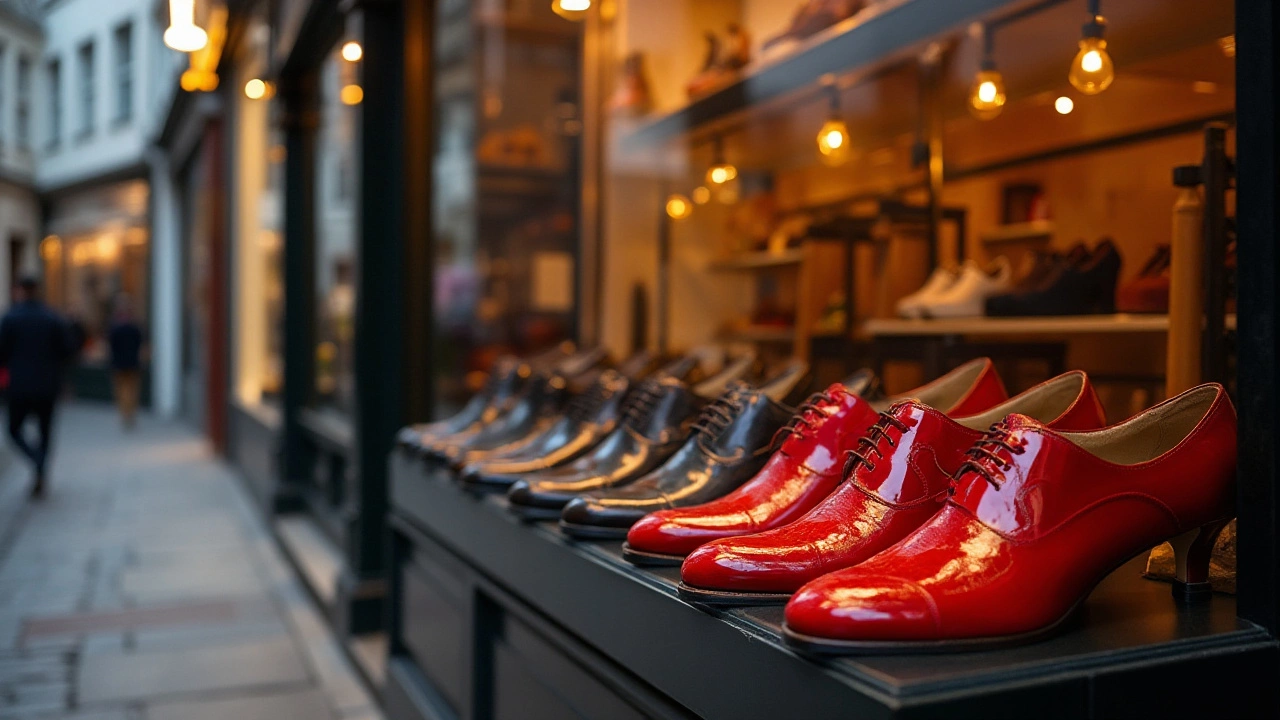If you've ever admired a pair of shoes that shimmer under the light, chances are you've encountered patent leather. This distinctive material is renowned for its radiant, almost mirror-like finish that can transform everyday footwear into a statement piece. But what exactly is patent leather, and how does it achieve its iconic shine?
Rooted deep in history, the innovation of patent leather was first realized to provide a durable yet eye-catching option for shoe enthusiasts. It became synonymous with formal events and special occasions, bridging the gap between practicality and elegance. This transformation happens through a unique process that coats the leather with a glossy surface, setting it apart from its matte counterparts.
In addition to its aesthetic appeal, patent leather offers remarkable durability, which makes it an attractive choice for long-lasting wear. However, its maintenance requires specific care rituals to keep the shine everlasting without succumbing to scuffs and scratches. These steps include regular cleaning and proper storage techniques, ensuring your shoes always look their best.
From understanding its historical roots to mastering maintenance, delving into the world of patent leather can elevate your shoe game remarkably. With the right knowledge and a few thoughtful strategies, your shiny shoes can remain the crowning jewel of your wardrobe.
- The Origin of Patent Leather
- How Patent Leather Gets Its Shine
- Caring for Your Shiny Shoes
- Interesting Facts and Tips
The Origin of Patent Leather
Patent leather, with its unmistakable shine, has a history as intriguing as its glossy finish. The tale begins in the early 19th century when inventor Seth Boyden, living in Newark, New Jersey, was inspired to create a new type of leather. In 1818, Boyden started experimenting, driven by the desire to craft a leather that was both beautiful and hard-wearing. His work culminated in 1819 when he successfully produced the first version of patent leather, achieving the lush shine that remains a hallmark today.
Boyden's method involved applying layers of a special lacquer coating to the leather, enhancing its natural features with a high-gloss surface. This coating process not only enhanced beauty but also provided an additional layer of protection against the elements. The new creation quickly gained traction, primarily used for formal footwear and accessories. By the mid-1820s, patent leather had captured the imagination of consumers, becoming incredibly popular in both Europe and America.
The industrial revolution played a significant role in the spread of patent leather. As manufacturing processes became more efficient, so did the production of this standout material. Its accessibility improved, allowing more people to enjoy its aesthetic and practical benefits. During this time, the leather industry saw remarkable innovation, with patent leather often leading the charge in fashion trends.
Interestingly, Seth Boyden never patented his invention, perhaps an ironic twist given the name. This lack of a patent didn't hinder its success, as the leather's unique lustrous appearance and durability were enough to embed it within the realm of luxury fashion. Many historical texts and experts agree patent leather continued to evolve through contributions from European tanneries, adding their specific touches to the production process over time.
Richard Smith, a notable historian specializing in fashion history, once said, "Patent leather ushered in a new era for footwear, symbolizing a shift towards more polished and sophisticated personal styles."
Patent leather's rich history reflects not just a story of ingenuity but also the evolution of consumer tastes over decades.Official adoption as the material of choice for formal occasions further cemented its place in wardrobes worldwide during the early 20th century.
Today, many of the traditional techniques used by Boyden have been refined, incorporating modern technologies that ensure patent leather remains at the forefront of stylish and functional shoe manufacturing. This historic material’s journey from its humble beginnings to its current status straddling innovation and elegance is a true testament to its timeless appeal, proving that the demand for durable yet dazzling footwear transcends generations.

How Patent Leather Gets Its Shine
The mesmerizing gloss of patent leather has an intriguing backstory, rooted in chemistry and craftsmanship. The process that gives patent leather its signature gleam begins with a carefully selected base of fine-grained leather or even synthetic alternatives, which is then treated to achieve that unmistakable high-gloss finish. The secret ingredient often lies in the application of a plastic coating. This involves layers of lacquer or synthetic resins that create a smooth, reflective surface.
Traditionally, the technique dates back to the early 19th century, credited to inventor Seth Boyden of Newark, New Jersey, who refined the process in 1818. His method, which involved linseed oil-based lacquers, transformed ordinary leather into a versatile, shiny material, making it popular for clothing, accessories, and of course, shiny shoes. The principle behind the shine hasn’t changed significantly since then, although modern advances in materials have made the process more efficient and lasting.
Today, most manufacturers use polyurethane or acrylic finishes that not only enhance the gloss but also serve as a protective layer, making the leather more resistant to water and stains. However, the quality of the shine can vary greatly among products due to the depth and type of coating materials used. Interestingly, technology and the desire for sustainable options have led some companies to experiment with more eco-friendly coatings. These newer methods not only aim to reduce the environmental impact but also offer improvements in the malleability and comfort of the leather.
In terms of care, maintaining this shine can sometimes be challenging. Patent leather, unlike traditional leather types, needs a tender approach when it comes to cleaning and storing since its outer layer, while protective, is also susceptible to scratches. This means opting for non-abrasive cloths and cleaners specifically designed for patent leather shoes to avoid dulling its shine.
To put into context the effort and chemistry involved, a quote from renowned leather expert, Dr. Lorna Gibson, highlights it well:
"The beauty of patent leather lies not just in the shine itself, but in the process—where a simple piece of animal hide is transformed into a gleaming, modern material."Her words capture the blend of art and science that characterizes the creation of such material, underscoring how innovation continues to enhance its application even today.

Caring for Your Shiny Shoes
Keeping your patent leather shoes looking brand new is more than worthwhile when those shoes are your pride and joy. The slick, glossy sheen that makes them stand out depends on a specific cleaning and maintenance routine that’s easy to master with the right approach. First and foremost, regular cleaning is crucial to preserve that signature polish. Dust and dirt can dull the shine, so take a microfiber cloth and delicately wipe the shoes after each wear. This simple act can go a long way to keep them glowing. Moreover, if there are any marks or sticky residues, a light dab of mineral oil or petroleum jelly on a soft cloth can work wonders. Gently rub the surface, and you’ll see how it restores the liquid gloss finish almost instantly.
Avoiding scratches is another essential aspect of care. Patent leather can be prone to scuffs, which can be heartbreaking. It’s best to store your shiny shoes in dust bags or wrap them in a soft cotton cloth to prevent them from rubbing against other items. If a nasty scratch does happen to mar your footwear, do not panic. A cotton swab dipped in a bit of leather conditioner can help minimize its appearance. Applying in a circular motion often helps blend it into the glossy surface.
Humidity and high temperatures are enemies of patent leather, leading to sticky or dull finishes. Store your shoes in a cool, dry place, ensuring they are safe from direct sunlight or heat sources. A closet with good air circulation is ideal. Adding silica gel packets to your storage can help absorb excess moisture. Some experts even suggest putting them back into their original shoe boxes or a specialized shoe storage cabinet.
"Taking care of your shoes is not about adding another task to your list; it's about preserving what makes you shine," says fashion designer Michael Kors.
Water damage can happen, especially in unpredictable weather. In the case of accidental soaking, quickly dry them with a cloth and let them air-dry naturally. Never use blow dryers or place them near heaters, as this can lead to cracking. It's often a good idea to treat them with a waterproof spray beforehand to add an extra layer of protection. This extra step can save you trouble later on, particularly during rainy seasons.
In terms of long-term maintenance, polish is generally unnecessary for patent leather. The coating provides its glossy appearance, so traditional shoe polish isn’t required. Instead, focus on those regular cleanings and occasional conditioning. Finally, as a preventative measure, overhaul your shoes with a visit to a professional cobbler when they start looking a bit worn down. A skilled professional can sometimes bring shoes back to life, extending their wearable years and keeping your patent leather collection at its absolute finest.

Interesting Facts and Tips
Patent leather, known for its distinctive glossy appearance, has a rich history and a few surprising facts that make it more intriguing. It was first introduced to the public in the early 19th century by inventor Seth Boyden from Newark, New Jersey. Boyden's breakthrough in 1818 was to apply a layer of linseed oil-based lacquer to prepare leather, creating an affordable, high-shine finish that was unprecedented at the time. This daring innovation fast-tracked patent leather from a mere novelty to a fashion staple worldwide. Today, the coatings have evolved to include modern materials such as plastic, enhancing both the durability and shine of the leather.
One might wonder how patent leather maintains its high-gloss effect. Well, it's not magic, but a meticulously crafted process. Manufacturers utilize a range of plastic coatings, specifically polyurethane or acrylic, to seal the leather with a waterproof surface. This not only gives it a classic shine but also adds a layer of protection against the elements. It means that patent leather shoes are not just fashionable – they're resilient too. Interestingly, while traditional leather is valued for its breathability, patent leather opts for glamour and weather resistance, which can sometimes compromise airflow. Careful wear, especially in extreme conditions, keeps your shoes at their best.
For the shoe aficionados interested in maintaining their shiny shoes, some practical tips could come in handy. Regular cleaning is essential; a simple wipe with a damp cloth can clear away dirt and smudges, keeping the surface spotless. Additionally, when storing, it's important to keep them away from direct sunlight and excessive heat, both of which can cause the lacquer to crack and fade. An interesting anecdote is that a little bit of mineral oil can revive the shine if it begins to dull. Simply apply with a soft cloth and buff gently. And because patent leather can be prone to scuffs, be sure to address them gradually with minimal pressure to avoid any long-lasting marks.
Another tip involves addressing the infamous sticky or tacky feeling that patent leather can sometimes develop. This can be combated simply by applying a small amount of petroleum jelly or a specialist patent leather conditioner. This not only removes the sticky residue but also makes the material supple and shiny again. Some enthusiasts swear by the effectiveness of micellar water, commonly used in skincare, as an excellent cleaning solution. It’s gentle enough for the sensitive lacquer yet powerful enough to cleanse residues.
For those interested in the cultural significance, patent leather has long been associated with formality and high fashion. In fact, patent leather shoes remain a classic choice for black-tie events and formal occasions. A lesser-known fact is that in World War II, it gained popularity in military uniforms due to its low maintenance and striking appearance. Today, it's a frequent choice for pop stars and celebs, displaying its timeless appeal across generations.
